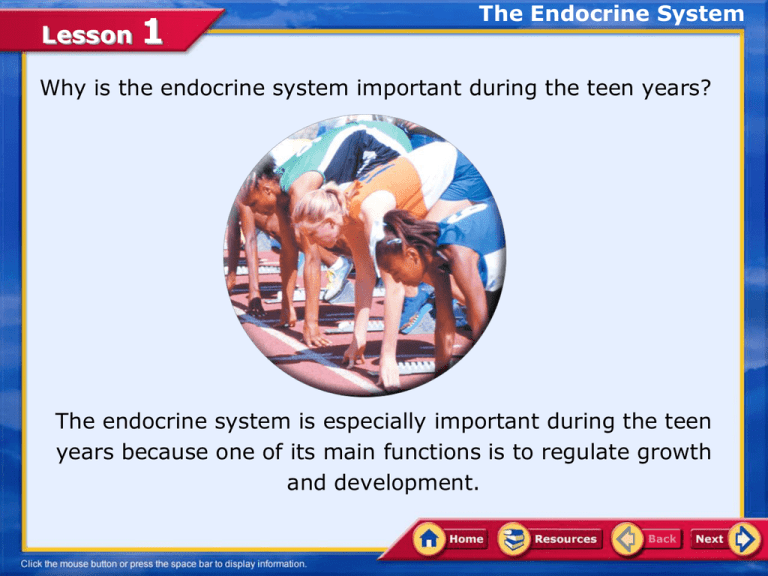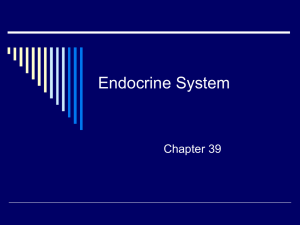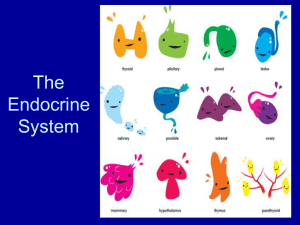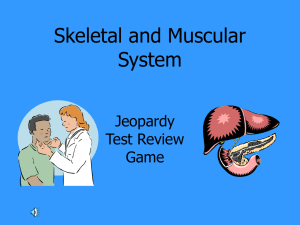Chap 18 Lesson 1 endocrine system
advertisement

Lesson 1 The Endocrine System Why is the endocrine system important during the teen years? The endocrine system is especially important during the teen years because one of its main functions is to regulate growth and development. Lesson 1 Lesson Objectives In this lesson, you will learn to: • Describe the glands of the endocrine system and the function of each • Examine the effects of health behaviors on the endocrine system Lesson 1 Structure of the Endocrine System The Endocrine System • The endocrine system consists of a network of endocrine glands located throughout the body. • Hormones are secreted by the endocrine glands and then carried to their destinations in the body by the blood. • Hormones produced during puberty trigger physical changes in the body. Lesson 1 Hormones Lesson 1 Structure of the Endocrine System Some Glands of the Endocrine System • Thyroid gland • Parathyroid glands • Hypothalamus • Pineal Gland • Testes and Ovaries • Thymus Gland • Pancreas Lesson 1 Structure of the Endocrine System Pituitary Gland The pituitary gland is known as the master gland. It has three sections, or lobes—anterior, intermediate, and posterior. Lesson 1 Structure of the Endocrine System Lobes of the Pituitary Gland Anterior Intermediate Posterior The anterior, or front, lobe of the pituitary gland produces six hormones. These hormones include somatotropic, or growth, hormone, thyroid stimulating hormone, and adrenocorticotropic hormone. Follicle-stimulating hormone (FSH) and luteinizing hormone (LH) control the growth, development, and functions of the gonads. Lesson Structure of the Endocrine System 1 Adrenal Glands The adrenal glands each have two parts. Adrenal Cortex Adrenal Medulla The adrenal cortex secretes a hormone that inhibits the amount of sodium excreted in urine and serves to maintain blood volume and pressure. It also secretes hormones that aid the metabolism of fats, proteins, and carbohydrates. Lesson 1 Lesson 1 Problems of the Endocrine System Serious Problems Diabetes Mellitus Graves’ Disease Cushing’s Disease Goiter Growth Disorders Lesson 1 Problems of the Endocrine System Diabetes Mellitus • Diabetes mellitus is a disorder in which the pancreas produces too little or no insulin, resulting in high blood glucose levels. • Symptoms include fatigue, weight loss, thirst, and frequent urination. Lesson 1 Problems of the Endocrine System Graves’ Disease • Graves’ disease, also called hyperthyroidism, is a disorder in which an overactive and enlarged thyroid gland produces excessive amounts of thyroxine. • Symptoms include nervousness, weight loss, increased thirst, rapid heartbeat, and intolerance for heat. • Low thyroxine production, called hypothyroidism, causes fatigue, dry skin, weight gain, constipation, and sensitivity to cold. Lesson 1 Problems of the Endocrine System Cushing’s Disease • Cushing’s disease results from the overproduction of adrenal hormones. • Symptoms include round face, humped upper back, thin and easily bruised skin, and fragile bones. Lesson 1 Problems of the Endocrine System Goiter • Goiter, an enlargement of the thyroid gland, is caused mainly by a lack of iodine in the diet. • Since the introduction of iodized salt, goiters have become rare in the United States. Lesson 1 Problems of the Endocrine System Growth Disorders • Growth disorders are caused by abnormal amounts of growth hormone. • With early diagnosis and proper treatment, a child with a growth disorder can reach a normal height. Lesson 1 Problems of the Endocrine System Care of the Endocrine System Eat nutritious meals, get enough sleep, and avoid stress. Get medical tests done by health care professionals to determine whether your endocrine function is normal. Lesson 1 Lesson 1 Quick Review Choose the appropriate option. Q. The ovaries and testes are also known by the name _________. 1. gonads 2. pituitary gland 3. goiter 4. adrenal cortex Lesson 1 Quick Review - Answer A. 1. gonads The ovaries and testes are also known by the name gonads. Click Next to attempt another question. Lesson 1 Quick Review Choose the appropriate option. Q. An endocrine gland is a ductless, or tubeless, organ or group of cells that secretes hormones directly into the bloodstream. True False Lesson A. 1 Quick Review - Answer True. An endocrine gland is a ductless, or tubeless, organ or group of cells that secretes hormones directly into the bloodstream. Click Next to attempt another question. Lesson Quick Review 1 Q. Which of the following are the two parts of the adrenal glands? 1. norepinephrine cortex and the redilin medulla. 2. epinephrine membrane and the adrenaline membrane. 3. adrenal cortex and the adrenal medulla. 4. anociferin cortex and the graves membrane. Lesson 1 Quick Review - Answer A. 3. adrenal cortex and the adrenal medulla. The two parts of the adrenal glands are adrenal cortex and the adrenal medulla. Click Next to attempt another question. Lesson 1 Quick Review Choose the appropriate option. Q. Many endocrine glands become more active during puberty, causing significant changes in adolescents, both male and female. True False Lesson 1 Quick Review - Answer A. True. Many endocrine glands become more active during puberty, causing significant changes in adolescents, both male and female. Click Next to attempt another question. Lesson 1 End of Lesson 1 Click Home to view the Main menu. Lesson 1 Quick Review - Answer A. Correct! The ovaries and testes are also known by the name gonads. Click Next to attempt another question. Lesson 1 Quick Review - Answer You have answered the question incorrectly. Go back to try again, or click Next to view the correct answer. Lesson 1 Structure of the Endocrine System Lobes of the Pituitary Gland Anterior Intermediate Posterior The intermediate, or middle, lobe of the pituitary secretes melanocyte-stimulating hormone (MSH), which controls the darkening of the skin by stimulating skin pigments. Lesson 1 Structure of the Endocrine System Lobes of the Pituitary Gland Anterior Intermediate Posterior The posterior, or rear, lobe of the pituitary gland secretes antidiuretic hormone (ADH), which regulates the balance of water in the body. ADH also produces oxytocin, which stimulates uterine contractions during the birth of a baby. Lesson 1 Structure of the Endocrine System Lobes of the Pituitary Gland Anterior Intermediate Posterior The anterior, or front, lobe of the pituitary gland produces six hormones. These hormones include somatotropic, or growth, A gonad is hormone, thyroid stimulating another name hormone, and adrenocorticotropic for thehormone. ovaries and testes. Follicle-stimulating hormone (FSH) and luteinizing hormone (LH) control the growth, development, and functions of the gonads. Lesson 1 Structure of the Endocrine System The Endocrine System • The endocrine system consists of a network of endocrine glands located throughout the body. • Hormones areAn secreted by the endocrine endocrine glands then or gland is aand ductless, carried to their destinations tubeless, organ or in the bodygroups by theof blood. cells that secretes hormones • Hormones produced directly into during the puberty bloodstream. trigger physical changes in the body. Lesson 1 Structure of the Endocrine System The Endocrine System • The endocrine system consists of a network of endocrine glands located throughout the body. • Hormones are secreted by the A hormone is a endocrine glands and then chemical substance carried to their destinations in thatblood. is produced in the body by the glands and helps • Hormones produced regulateduring many of your puberty trigger physical changes body’s functions. in the body. Lesson 1 Structure of the Endocrine System Pituitary Gland The pituitary gland is known as the master gland. It has three sections, or lobes—anterior, intermediate, and posterior. The pituitary gland regulates and controls the activities of all of the other endocrine glands. Lesson 1 Structure of the Endocrine System Adrenal Glands The adrenal glands each have two parts. Adrenal Cortex Adrenal Medulla The adrenal adrenal gland is aThe gland that cortex secretes a hormone inhibits the amount of sodium helps thethat body excreted in urine and serves to recover from stress maintain blood volume and pressure. and respond to emergencies. It also secretes hormones that aid the metabolism of fats, proteins, and carbohydrates. Lesson Structure of the Endocrine System 1 Adrenal Glands The adrenal glands each have two parts. Adrenal Cortex Adrenal Medulla The adrenal medulla is controlled by the hypothalamus and the autonomic nervous system. It secretes the hormones epinephrine (also called adrenaline) and norepinephrine. Lesson Structure of the Endocrine System 1 Adrenal Glands The adrenal glands each have two parts. Adrenal Cortex Adrenal Medulla The adrenal adrenal gland is aThe gland that medulla is controlled by hypothalamus and the autonomic helps the the body nervous system. recover from stress and respond to It secretes the hormones epinephrine emergencies. (also called adrenaline) and norepinephrine. Lesson 1 Structure of the Endocrine System Some Glands of the Endocrine System • Thyroid gland • Parathyroid glands The thyroid • Hypothalamus gland produces hormones • Pineal Gland that regulate metabolism, • Testes and Ovaries body heat, and bone growth. • Thymus Gland • Pancreas Lesson 1 Structure of the Endocrine System Some Glands of the Endocrine System • Thyroid gland • Parathyroid glands • Hypothalamus • • • • The parathyroid Pineal Gland gland produces a hormone that Testes and Ovaries regulates the body’s Thymus Gland calcium and phosphorous balance. Pancreas Lesson 1 Structure of the Endocrine System Some Glands of the Endocrine System • Thyroid gland • Parathyroid glands • Hypothalamus • Pineal Gland The pancreas is a gland that serves • Testes and Ovaries two systems - the digestive and the • Thymus Gland endocrine systems. • Pancreas Lesson 1 Quick Review - Answer A. Correct! An endocrine gland is a ductless, or tubeless, organ or group of cells that secretes hormones directly into the bloodstream. Click Next to attempt another question. Lesson 1 Quick Review - Answer You have answered the question incorrectly. Go back to try again, or click Next to view the correct answer. Lesson 1 Quick Review - Answer A. Correct! The two parts of the adrenal glands are: adrenal cortex and the adrenal medulla. Click Next to attempt another question. Lesson 1 Quick Review - Answer You have answered the question incorrectly. Go back to try again, or click Next to view the correct answer. Lesson 1 A. Correct! Many endocrine glands become more active during puberty, causing significant changes in adolescents, both male and female. Lesson 1 Quick Review - Answer You have answered the question incorrectly. Go back to try again, or click Next to view the correct answer.









